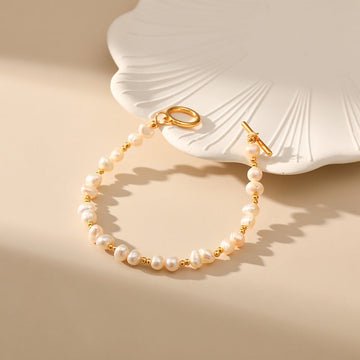The Blue-Green Hues and Mineral Characteristics of Amazonite Bracelets
Amazonite, a variety of microcline feldspar, is celebrated for its captivating blue-green coloration, which ranges from soft pastel turquoise to vibrant teal. This gemstone has been used in jewelry, including bracelets, for centuries, valued for both its aesthetic appeal and its association with harmony and balance. The distinct color and physical properties of amazonite are rooted in its mineral composition and geological formation, offering insights into its unique beauty and durability.
1. The Origin of Amazonite’s Blue-Green Color: Trace Elements and Structural Factors
The characteristic blue-green shade of amazonite is primarily attributed to the presence of trace amounts of lead and water within its crystal structure. Unlike other feldspars, which are typically colorless or white, amazonite’s color arises from a combination of these impurities and light scattering effects. Lead ions, incorporated during the stone’s formation, interact with visible light, absorbing certain wavelengths and reflecting others to produce the observed hues. Additionally, microscopic inclusions or exsolution lamellae—thin layers of albite or other minerals within the amazonite—can scatter light, enhancing the color’s intensity and creating a shimmering effect known as “schiller.”
The Role of Geological Conditions in Color Variation
The specific shade of amazonite can vary significantly depending on the conditions under which it formed. For instance, higher concentrations of lead or prolonged exposure to hydrothermal fluids during crystallization may result in deeper, more saturated colors. Conversely, lower lead content or faster cooling rates can produce paler tones. Some amazonite specimens also exhibit pleochroism, displaying different colors when viewed from different angles, though this effect is often subtle. The interplay of these factors ensures that no two amazonite bracelets are identical, even when sourced from the same location.
2. Mineral Composition and Crystal Structure of Amazonite
Amazonite belongs to the potassium feldspar group, specifically the microcline variety, which crystallizes in the triclinic system. Its chemical formula is KAlSi₃O₈, though the substitution of aluminum (Al) with iron (Fe) or other elements can slightly alter its properties. The crystal structure consists of interconnected tetrahedra of silicon and oxygen, with potassium ions occupying spaces between them. This arrangement gives amazonite its characteristic cleavage—a tendency to break along smooth, flat planes—which can influence how it is cut and polished for bracelets.
Hardness and Durability for Jewelry Use
With a hardness of 6 to 6.5 on the Mohs scale, amazonite is moderately durable, making it suitable for everyday wear in bracelets. However, its cleavage planes can make it prone to chipping or breaking if struck at certain angles. To mitigate this, jewelers often set amazonite stones in protective bezels or prong settings that minimize exposure to impact. Additionally, avoiding exposure to harsh chemicals or extreme temperatures helps preserve the stone’s color and structural integrity over time.
3. Identifying Natural Amazonite: Key Visual and Physical Properties
Natural amazonite can be distinguished from imitations or similar-looking stones by several features. Its blue-green color is typically uneven, with subtle variations in shade that create a mottled or streaked appearance. Under magnification, the stone may reveal fine, parallel inclusions or a granular texture caused by the intergrowth of microcline and albite. Another telltale sign is the presence of white streaks or patches, which result from alternating layers of feldspar minerals. These features are difficult to replicate in synthetic materials, making them reliable indicators of authenticity.
Optical Phenomena and Inclusions
Some amazonite specimens exhibit a cat’s-eye effect or asterism when cut en cabochon, though this is relatively rare. More commonly, the stone’s inclusions create a soft, glowing sheen that enhances its blue-green color. Inclusions of other minerals, such as quartz or mica, may also be present, adding to the stone’s visual complexity. When selecting amazonite for a bracelet, collectors often prioritize stones with a balance of color intensity and interesting internal patterns, as these traits contribute to the piece’s uniqueness.
4. Geological Sources and Regional Characteristics of Amazonite
Amazonite is found in pegmatite veins, which are coarse-grained igneous rocks formed during the final stages of magma crystallization. Major deposits exist in several regions worldwide, including Russia, Brazil, Madagascar, and the United States (particularly Colorado and Virginia). Each location produces amazonite with distinct characteristics. For example, Russian amazonite is often prized for its deep, vivid teal color, while specimens from Colorado may display a more muted, pastel tone. The geological history of these areas, including the composition of the parent rock and the tectonic forces at play, influences the stone’s color, clarity, and inclusion patterns.
Environmental Factors During Formation
The presence of hydrothermal fluids during amazonite’s growth plays a crucial role in determining its color and texture. These fluids, rich in dissolved minerals, can alter the stone’s chemical composition and introduce impurities that affect its appearance. For instance, prolonged exposure to lead-rich fluids may result in darker, more saturated hues, while shorter exposure times or lower concentrations yield paler colors. Understanding these processes helps gemologists and collectors appreciate the natural variability of amazonite and its suitability for crafting distinctive bracelets.
A Gemstone of Earth’s Artistry
Amazonite’s blue-green tones and mineral characteristics are a testament to the intricate interplay of geological forces and chemical processes. From its trace-element-induced coloration to its durable yet cleavage-prone structure, every aspect of amazonite reflects millions of years of Earth’s history. Whether worn as a symbol of tranquility or admired for its scientific marvel, amazonite continues to enchant with its serene beauty and rich mineral heritage, making it a timeless choice for bracelets and other jewelry.







